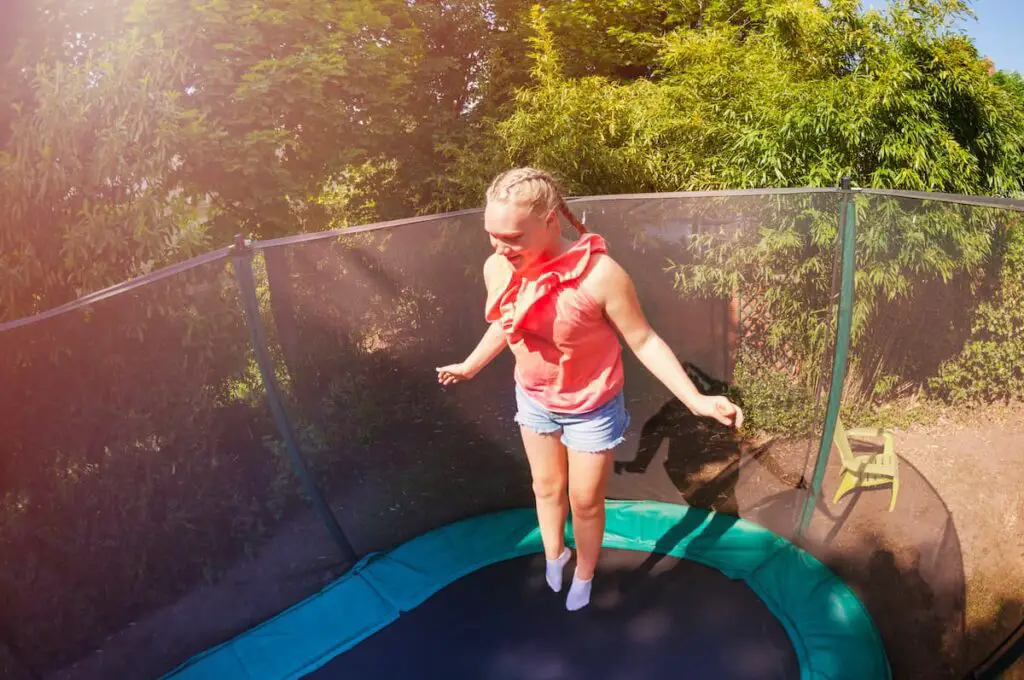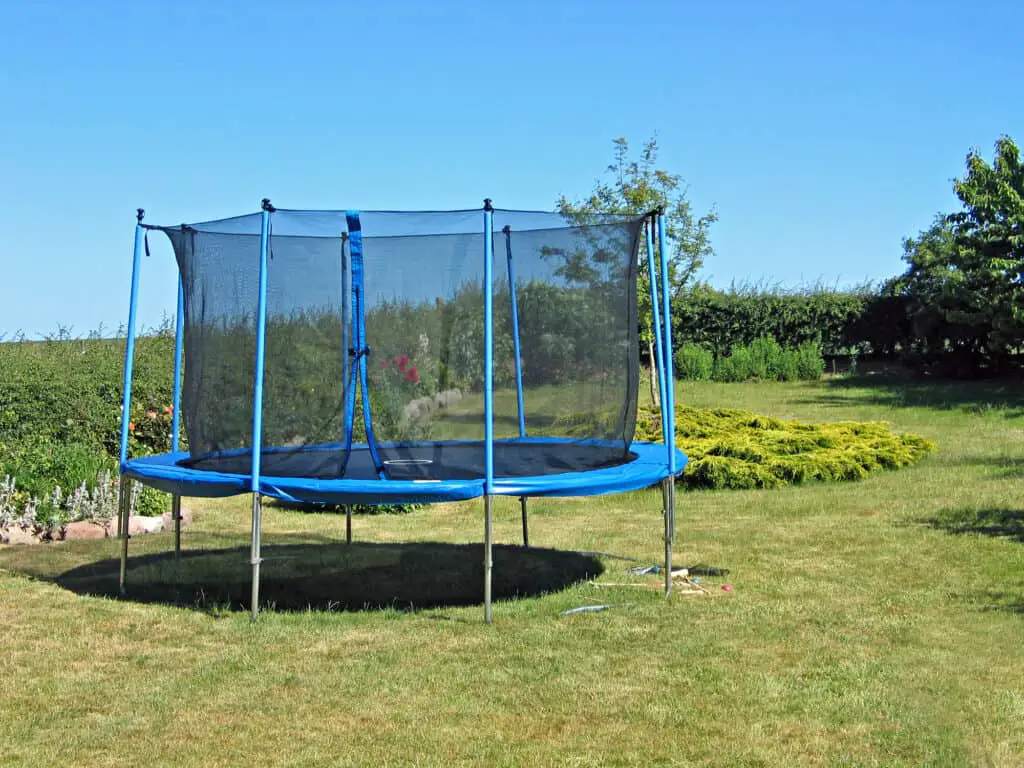Trampolines on concrete can be dangerous, but there are ways to reduce the danger they possess significantly!
Is this safe? Will your kids be placed in added danger by jumping on trampolines on concrete?
Short answer: yes. But luckily, there are ways to keep trampolines on concrete safe for users!
All homeowners have heard the advice that simply owning a trampoline will cause your insurance costs to go up.
While your insurance company may not immediately raise your rates upon purchasing a trampoline, they may recommend additional policies in case of injury.
One of the most common questions regarding trampoline safety involves where to place them in your yard.
Many backyards have limited grassy areas, requiring homeowners to place trampolines on concrete.
If your yard is mainly concrete or asphalt, do not fret – you can childproof that patch so that your kids can still have fun outside on the trampoline.
Here are a few tips and tricks to make your backyard a safe place for trampoline fun.

Related Reading: Can You Use a Trampoline in the Winter? & Can You Put a Trampoline on Decking?
Table of Contents
Safety Tips For Trampolines On Concrete
Inherently, a trampoline on a concrete surface is not a safe idea.
Trampolines can cause injuries, so it’s important to limit risks, especially if falling onto concrete.
That’s why most people suggest placing your trampoline on a soft surface like grass or surrounding the trampoline with a net to prevent falling off altogether.
But what if you have no choice and concrete is the only surface space available?
Experts recommend finding a safer backyard activity instead of using a trampoline.
While there is some merit to that statement, there are alternatives that allow you to keep your children and guests safe.
Provide a Soft Base
One of the best ways to limit the risk of injury on concrete is with rubber padding.
With the proper rubber padding, you provide the same soft cushioning as grass.
Using rubber padding can help make trampolines safer for kids, but it’s not foolproof.
Gym floor mats are a fantastic option for cushioning the concrete fall.
An affordable alternative would be to utilize interlocking exercise tiles.
They’re much cheaper than gym mats and can easily be moved and shaped to fit the size of your trampolines.
With either of these types of rubber mats in place, the risk of severe injury from a fall is substantially reduced.
Specialized companies place rubber mats under trampolines on concrete for added safety.
While the cost of installation might be pretty high, it certainly offers peace of mind and adequate protection.
Medical bills or increased insurance resulting from a trampoline accident can outweigh the fun.
Related Reading: Trampoline Injury Prevention
Anchor a Trampoline on Concrete
Why should you anchor trampolines on concrete?
It’s rarely suggested for grass, so why here?
The chances of your trampoline moving around and becoming compromised are far greater on concrete than grass.
While on grass, a trampoline sinks into the mud/dirt and has far greater friction than concrete.
Without proper anchoring, the trampoline is likely to move, which could lead to injury.
Unfortunately, proper anchoring becomes much more difficult without concrete anchoring kits.
This leaves you with two options: 1, drill into the ground or 2, weigh it down with heavy objects.
This would be the more secure option for drilling, but could be much more labor-intensive.
You’ll have to drill into concrete and create pegs that can easily hold the trampoline down while in use.
Using heavy objects such as sandbags is easier and less expensive.
These bags can be draped over the legs of the trampoline and will hold it down while in use.
They’re not as secure as drilling into the concrete, but the process is much more straightforward and can be done by anyone.
You are sacrificing some level of security, but not much.
Get a Trampoline Net
One of the best ways to prevent people from falling off trampolines on concrete is with a trampoline net.
This is true for any surface where your trampoline will be placed.
Encasing the jumping area provides safety and prevents falls.
This is not a foolproof method to protect your children from falling on hard surfaces. It is highly recommended you use the rubber mat and net together.
This will provide an extra layer of protection for trampolines on concrete, giving peace of mind.
The safety net doesn’t account for the space between the jumping surface and the springs. This is commonplace for kids to fall through and hurt themselves.
Nonetheless, having a net in place will drastically decrease the chances of injury and is a fantastic addition to your trampoline.
If there are thoughts of placing trampolines on concrete, then nets, in addition to rubber mats and some anchoring are best practices.

Best Places for a Trampoline Outside
While I would not recommend trampolines on concrete, I understand that you sometimes have no choice.
As long as proper safety measures are in place and the concrete is safe to jump on, it’s okay.
Here are the best places for a trampoline to be placed outside.
I am listing outdoor locations. It is typically not safe nor recommended to have your trampoline indoors.
These options take safety and installation into account.
The easier it is to keep your kids safe without spending too much money, the better the place for your trampoline.
Grass
If you have a grassy area in your yard with enough horizontal and vertical space for your trampoline, place it there.
No matter how much safety-proofing you do, nothing can beat the natural give of a grassy surface.
Placing your trampoline on your lawn offers your kids a soft landing and requires no additional anchoring.
Finding a flat grassy surface can be difficult, but if you’ve got it, you were meant to have a trampoline there!
If your grassy surface isn’t flat, you might need to do some terraforming to make it safe for your kids.
Dirt
The next best place for your trampoline is an area with dirt.
The issue with dirt is that it lacks a natural anchor, making it less safe than grass.
The grassroots acts as a hold for the dirt, making it secure and safe to jump on.
Without the grass, the dirt is free to move, which can compromise the trampoline’s structure.
As long as you have a secure area where the dirt is unlikely to move, you should be good to place a trampoline there.
Dirt provides give and a natural cushion should your kids fall off the trampoline.
When the soil becomes too dry or too cold, it hardens.
Be careful when placing your trampoline on a mound of dirt, as it is likely to shift, especially in heavy rain or wind.
Padding
The final recommended placement for your trampoline is on padding.
Adding padding to a trampoline is a great way to increase safety whether it’s on concrete or grass.
It provides an added cushion that could prevent injury to your kids. Having any sort of rubber padding in place is much better.
Final Thoughts Regarding Trampolines on Concrete
When purchasing a trampoline, safety should be the top priority.
It’s impossible to eliminate all chances of injury, especially on a trampoline. However, having as many safety measures in place as possible can be invaluable.
Trampolines are an enjoyable pastime, however, it is crucial to acknowledge the potential hazards associated with them.
If you are limited to placing your trampoline on concrete, take extra safety measures to protect your children.
Enjoy living the outdoor life!
